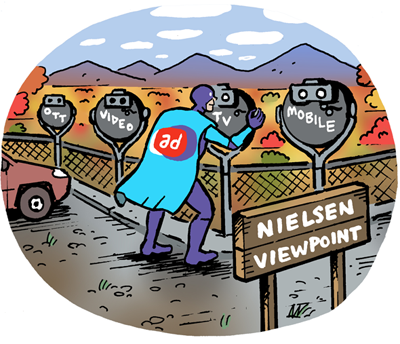
The priority for TV ad measurement players right now is to get their hands on as much data – automated content recognition data, in particular – as they possibly can.
Or, at least, that’s the idea behind measurement provider Samba TV’s latest software acquisition.
On Tuesday, Samba announced its acquisition of the St. Louis-based AI startup Disruptel to bolster its machine learning chops, namely in automatic content recognition (ACR). Terms of the deal were not disclosed.
Disruptel launched in 2017 with the goal to become a voice-activation solution built-in with connected TVs. Its products were designed to help consumers talk to their smart TVs to ask about what’s on or about something they’re watching (ideally, where to buy something from a commercial).
But fancy voice activations aside, Disruptel’s tech is built on the ACR value prop of show-level content identification and analysis, and being able to spot when a particular ad actually played to a room, said Samba CEO Ashwin Navin.
Samba invented chipset level tech in 2011 to transmit content viewership data from smart TVs, which is why the company claims it invented ACR. And because ACR is based on device-level data, it’s dramatically changed how linear campaigns are attributed, Navin said. GRPs used to be standard currency for TV ads.
Which is why, according to Navin, “AI will be no less important for linear TV than it is for over-the-top (OTT) streaming.”
Everything’s an ad
Disruptel frames its tech as a way to create alternate ad formats that are less interruptive than typical 15- or 30-second commercials (and thus more likely to ultimately drive sales, goes the sell).
Consumers with Disruptel-enabled smart TVs (which include some TCL TVs) can ask about actors appearing on-screen, including what they’re wearing, which retailers sell those products and for how much.
Navin said Samba will incorporate Disruptel’s tech into its conversion-based measurement. And that the content recognition and shopper-linking service could include in-game advertising and closer collaboration with retailers.
At the get-go, though, Samba and Disruptel are focused on merging their tech and teams, which is hard work and precarious.
Setting the scene
Samba’s first step will be to run Disruptel’s recognition tech on a library of programming to detect trends that brands might be interested in, Navin said, including which types of products drive sales and interactions from an audience watching TV.
Brands have already inquired about Disruptel’s show-level specificity, Alex Quinn, founder of the company, told AdExchanger. Questions arose, like whether Disruptel could display ad placements for shampoo only in scenes that feature a shower (in other words, the kinds of adjacency questions typical of programmatic web and video contextual placements).
Linear TV advertisers, meanwhile, are demonstrating a “digital-like rigor” to valuing their media buys, Navin said.
Much ado about measurement
Regardless of an aversion to three-letter acronyms, the TV business will eventually transact ads primarily on real-time impressions.
Easier said than done on linear, though. Nielsen is still in a yearslong overhaul of its panel-based metrics into impression-based ratings. And, in contrast to ad-supported streaming media, linear TV is still in the early phases in terms of advertising based on addressability or targeted to individual devices or logged-in accounts.
The industry is in a chicken-and-egg problem. ACR and other data-driven TV advertising methods need to reach a representative and statistically significant number of households to work well, Navin said. Neither broadcasters nor advertisers will invest without seeing the scale they need from the other side.
Navin added that TV measurement currency starts with accurately counting deduplicated reach. “Anything that a brand is invested in should be measurable,” he said.






 By
By 



